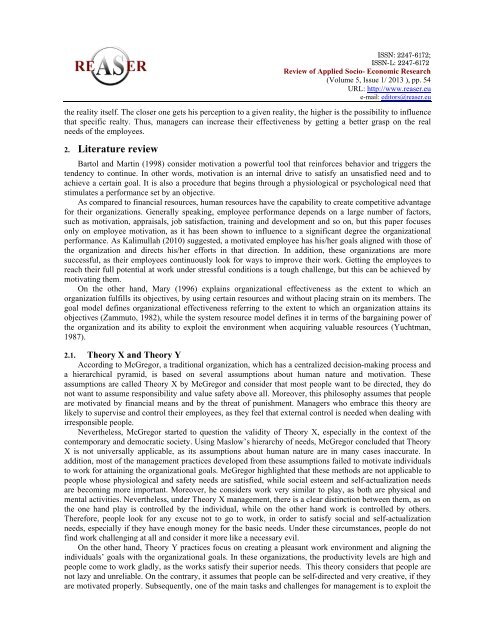new characteristics of inequalities in the information society and ...
new characteristics of inequalities in the information society and ...
new characteristics of inequalities in the information society and ...
You also want an ePaper? Increase the reach of your titles
YUMPU automatically turns print PDFs into web optimized ePapers that Google loves.
ISSN: 2247-6172;<br />
ISSN-L: 2247-6172<br />
Review <strong>of</strong> Applied Socio- Economic Research<br />
(Volume 5, Issue 1/ 2013 ), pp. 54<br />
URL: http://www.reaser.eu<br />
e-mail: editors@reaser.eu<br />
<strong>the</strong> reality itself. The closer one gets his perception to a given reality, <strong>the</strong> higher is <strong>the</strong> possibility to <strong>in</strong>fluence<br />
that specific realty. Thus, managers can <strong>in</strong>crease <strong>the</strong>ir effectiveness by gett<strong>in</strong>g a better grasp on <strong>the</strong> real<br />
needs <strong>of</strong> <strong>the</strong> employees.<br />
2. Literature review<br />
Bartol <strong>and</strong> Mart<strong>in</strong> (1998) consider motivation a powerful tool that re<strong>in</strong>forces behavior <strong>and</strong> triggers <strong>the</strong><br />
tendency to cont<strong>in</strong>ue. In o<strong>the</strong>r words, motivation is an <strong>in</strong>ternal drive to satisfy an unsatisfied need <strong>and</strong> to<br />
achieve a certa<strong>in</strong> goal. It is also a procedure that beg<strong>in</strong>s through a physiological or psychological need that<br />
stimulates a performance set by an objective.<br />
As compared to f<strong>in</strong>ancial resources, human resources have <strong>the</strong> capability to create competitive advantage<br />
for <strong>the</strong>ir organizations. Generally speak<strong>in</strong>g, employee performance depends on a large number <strong>of</strong> factors,<br />
such as motivation, appraisals, job satisfaction, tra<strong>in</strong><strong>in</strong>g <strong>and</strong> development <strong>and</strong> so on, but this paper focuses<br />
only on employee motivation, as it has been shown to <strong>in</strong>fluence to a significant degree <strong>the</strong> organizational<br />
performance. As Kalimullah (2010) suggested, a motivated employee has his/her goals aligned with those <strong>of</strong><br />
<strong>the</strong> organization <strong>and</strong> directs his/her efforts <strong>in</strong> that direction. In addition, <strong>the</strong>se organizations are more<br />
successful, as <strong>the</strong>ir employees cont<strong>in</strong>uously look for ways to improve <strong>the</strong>ir work. Gett<strong>in</strong>g <strong>the</strong> employees to<br />
reach <strong>the</strong>ir full potential at work under stressful conditions is a tough challenge, but this can be achieved by<br />
motivat<strong>in</strong>g <strong>the</strong>m.<br />
On <strong>the</strong> o<strong>the</strong>r h<strong>and</strong>, Mary (1996) expla<strong>in</strong>s organizational effectiveness as <strong>the</strong> extent to which an<br />
organization fulfills its objectives, by us<strong>in</strong>g certa<strong>in</strong> resources <strong>and</strong> without plac<strong>in</strong>g stra<strong>in</strong> on its members. The<br />
goal model def<strong>in</strong>es organizational effectiveness referr<strong>in</strong>g to <strong>the</strong> extent to which an organization atta<strong>in</strong>s its<br />
objectives (Zammuto, 1982), while <strong>the</strong> system resource model def<strong>in</strong>es it <strong>in</strong> terms <strong>of</strong> <strong>the</strong> barga<strong>in</strong><strong>in</strong>g power <strong>of</strong><br />
<strong>the</strong> organization <strong>and</strong> its ability to exploit <strong>the</strong> environment when acquir<strong>in</strong>g valuable resources (Yuchtman,<br />
1987).<br />
2.1. Theory X <strong>and</strong> Theory Y<br />
Accord<strong>in</strong>g to McGregor, a traditional organization, which has a centralized decision-mak<strong>in</strong>g process <strong>and</strong><br />
a hierarchical pyramid, is based on several assumptions about human nature <strong>and</strong> motivation. These<br />
assumptions are called Theory X by McGregor <strong>and</strong> consider that most people want to be directed, <strong>the</strong>y do<br />
not want to assume responsibility <strong>and</strong> value safety above all. Moreover, this philosophy assumes that people<br />
are motivated by f<strong>in</strong>ancial means <strong>and</strong> by <strong>the</strong> threat <strong>of</strong> punishment. Managers who embrace this <strong>the</strong>ory are<br />
likely to supervise <strong>and</strong> control <strong>the</strong>ir employees, as <strong>the</strong>y feel that external control is needed when deal<strong>in</strong>g with<br />
irresponsible people.<br />
Never<strong>the</strong>less, McGregor started to question <strong>the</strong> validity <strong>of</strong> Theory X, especially <strong>in</strong> <strong>the</strong> context <strong>of</strong> <strong>the</strong><br />
contemporary <strong>and</strong> democratic <strong>society</strong>. Us<strong>in</strong>g Maslow’s hierarchy <strong>of</strong> needs, McGregor concluded that Theory<br />
X is not universally applicable, as its assumptions about human nature are <strong>in</strong> many cases <strong>in</strong>accurate. In<br />
addition, most <strong>of</strong> <strong>the</strong> management practices developed from <strong>the</strong>se assumptions failed to motivate <strong>in</strong>dividuals<br />
to work for atta<strong>in</strong><strong>in</strong>g <strong>the</strong> organizational goals. McGregor highlighted that <strong>the</strong>se methods are not applicable to<br />
people whose physiological <strong>and</strong> safety needs are satisfied, while social esteem <strong>and</strong> self-actualization needs<br />
are becom<strong>in</strong>g more important. Moreover, he considers work very similar to play, as both are physical <strong>and</strong><br />
mental activities. Never<strong>the</strong>less, under Theory X management, <strong>the</strong>re is a clear dist<strong>in</strong>ction between <strong>the</strong>m, as on<br />
<strong>the</strong> one h<strong>and</strong> play is controlled by <strong>the</strong> <strong>in</strong>dividual, while on <strong>the</strong> o<strong>the</strong>r h<strong>and</strong> work is controlled by o<strong>the</strong>rs.<br />
Therefore, people look for any excuse not to go to work, <strong>in</strong> order to satisfy social <strong>and</strong> self-actualization<br />
needs, especially if <strong>the</strong>y have enough money for <strong>the</strong> basic needs. Under <strong>the</strong>se circumstances, people do not<br />
f<strong>in</strong>d work challeng<strong>in</strong>g at all <strong>and</strong> consider it more like a necessary evil.<br />
On <strong>the</strong> o<strong>the</strong>r h<strong>and</strong>, Theory Y practices focus on creat<strong>in</strong>g a pleasant work environment <strong>and</strong> align<strong>in</strong>g <strong>the</strong><br />
<strong>in</strong>dividuals’ goals with <strong>the</strong> organizational goals. In <strong>the</strong>se organizations, <strong>the</strong> productivity levels are high <strong>and</strong><br />
people come to work gladly, as <strong>the</strong> works satisfy <strong>the</strong>ir superior needs. This <strong>the</strong>ory considers that people are<br />
not lazy <strong>and</strong> unreliable. On <strong>the</strong> contrary, it assumes that people can be self-directed <strong>and</strong> very creative, if <strong>the</strong>y<br />
are motivated properly. Subsequently, one <strong>of</strong> <strong>the</strong> ma<strong>in</strong> tasks <strong>and</strong> challenges for management is to exploit <strong>the</strong>








